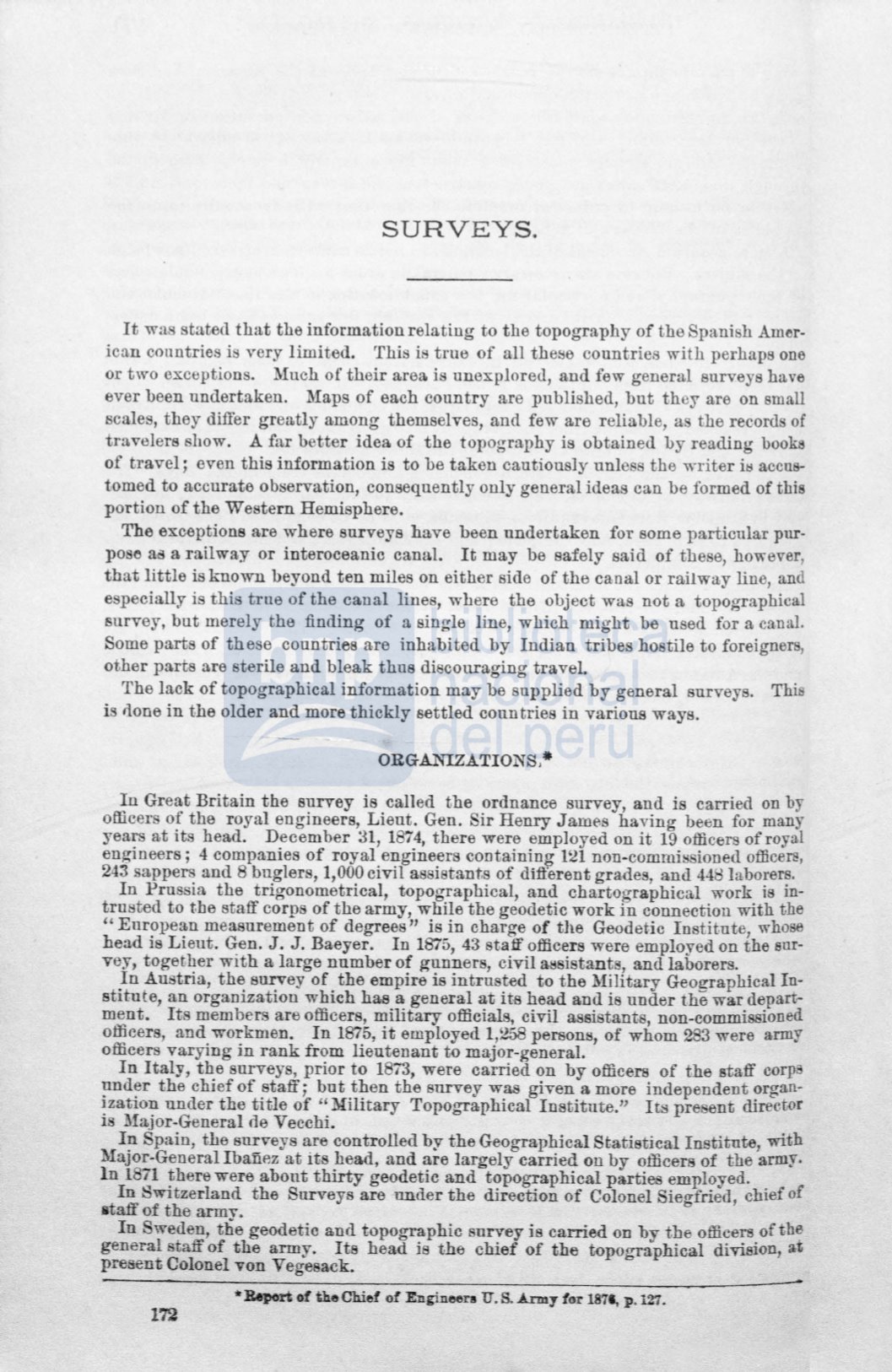

SURVEYS.
1t
wus stated that the information relating to the topography of the Spanish Amer–
ic:.m conntries is very limited. This is true of all these countries with perhaps one
or two exceptions. Much of their area is unexplored, and few general surveys have
ever been underta.ken. Mapa of each country are published, but they are on small
scales, they differ greatly among themselves, and few are reliable, as the records of
travelers slww. A far better idea of the topography is obtained by reading books
of travel; even this information is to be taken cautiously unle s the wTiter
i~
accus–
tomed to accurate observation, consequently only general ideas can be formed of this
portion of the Western Hemisphere.
The exceptions are where surveys have been undertaken for sorne particular pur·
pose a¡¡ a ra.ilway or interoceanic canal.
It
may be safely said of these, however,
that little is known beyond ten miles on either side of the canal or railway line, and
especially is this true of the canal linea, where the object was not a topographical
survey, but merely the finding of a single line, which might be used for a canal.
Sorne parta of these countries are inhabited by ludian tribes hostile to foreigners,
other parta are sterile and bleak thus discouraging travel.
The lack of topographical information may be supplied by general surveys. This
tlone in the older and more thickly settled countries in various ways.
ORGANIZ.A.TIONS,•
In Great Britain the survey is called the ordnance survey, and is carried on by
offi.cers of the royal engineers, Lieut. Gen. Sir Henry James having been for many
years at
its
head. December 31, 1 74, there were employed on it 19 offi.cers ofroyal
engineers; 4 companies of royal engineers containing 121 non-commü; ioned officer!!,
243 sappers and
buglers, 1,000 civil assistants of difl'erent grades, and 44
laborera.
In Prussia the trigonometrical, topograpbical, and chartographical work is in–
trusted to the staff corps ofthe army, while the geodetic work in connectiou with the
"European measurement of degrees" is in charge of the Geodetic Institute, whose
head is Lieut. Gen. J. J. Baeyer.
In 1875, 43 staff officers were employed on the sur–
vey, together with a large number of gunners, civil a¡;sistants, and laborera.
In Austria., the survey of the empire is intru
ted
to the Military Geographical In–
stitute, an organiza.tion which has a general at ita head and is under the wardepart–
ment.
It
members are officers, military officials, civil assi tanta, non-commissioned
officers, and workmen.
In 1875,
it
employed 1,258 persona, of whom 283 were anny
officers varying in rank from lieutenant to major-general.
In Italy, the surveys, prior to 18i3, were carried on by officers of the staff corp
under the chief of staff; but then the survey was given a more independent organ–
ization under the title of "Military Topographical Institute." Its pre ent director
is Major-General de Vecchi.
..
In Spain, the surveys are controlled by the Geographical Statistical Institute, mth
Major-General Ibañez at
it
head, and are largely carried on by officers of the arroy.
ln 1
i1
tbere were abont thirty geodetic and topographical parties employed.
In8witzerland the Surveys are under the direction of Colonel Siegfried, chief of
ata.ffof the armv.
InS veden, the geodetio and topographic survey is carried on by the officers of tbe
general taff of the army.
Its head is the chief of the topographical division, at
present Colonel von Vegesack.
• Beport
of ihe Chief of Engineera U.
S.
Army
for 1871. p. l27.
172
















